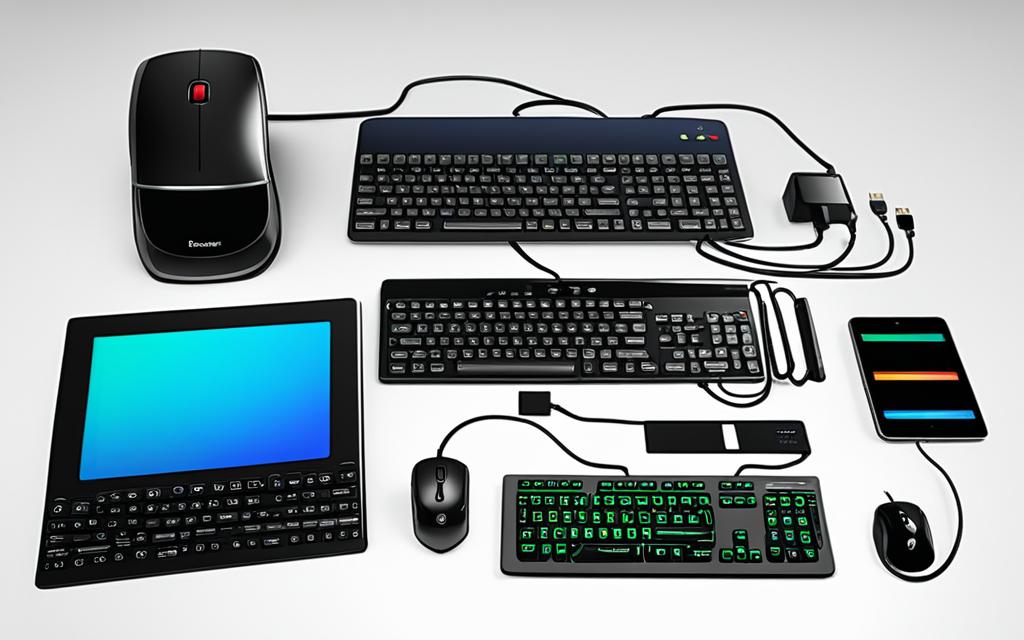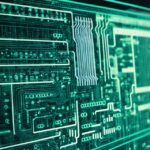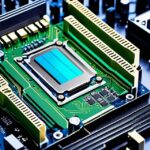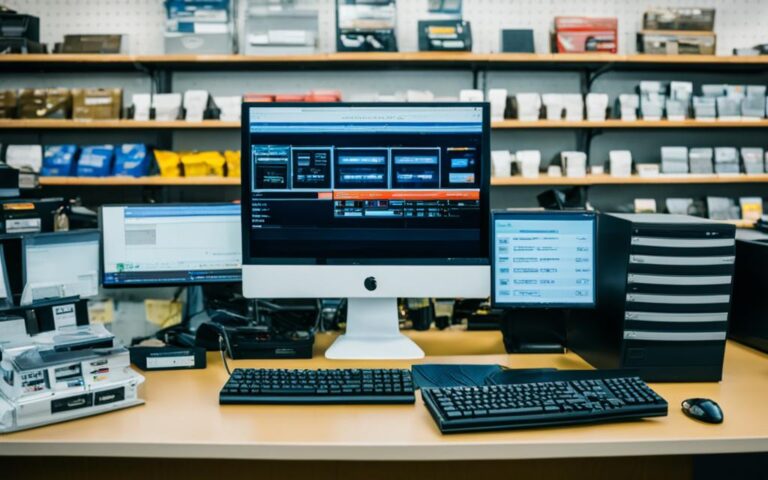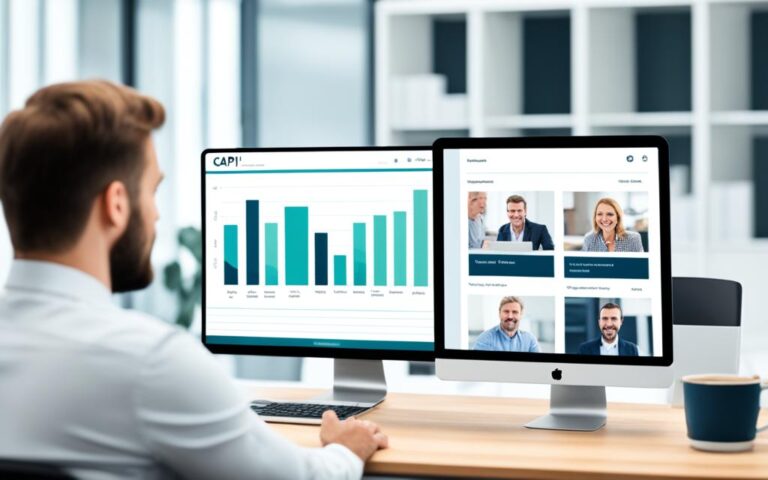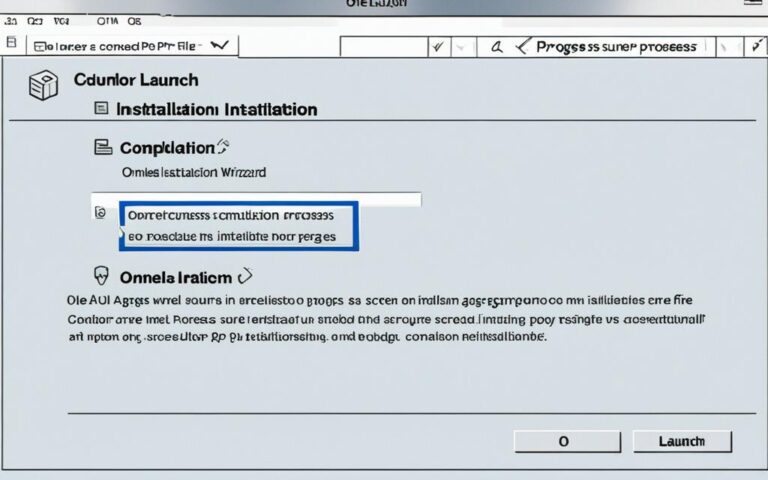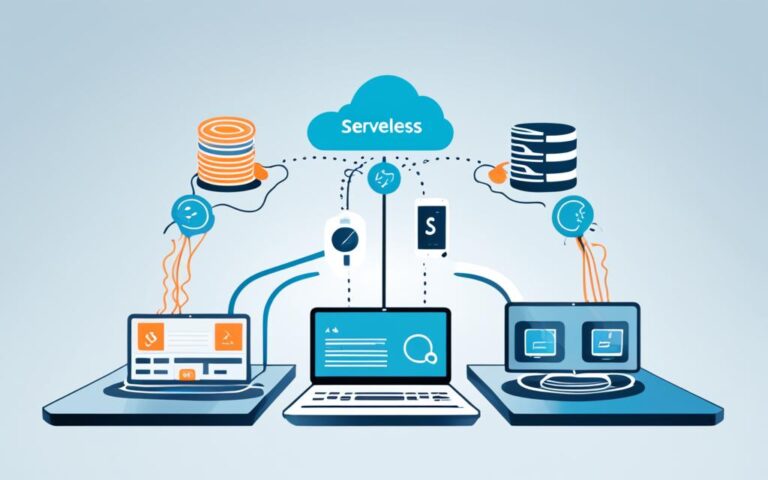The crossword clue solver says the answer is a 4-letter word: DATA1. This term means a bunch of facts ready for analysis or research. It’s what a computer uses as its input.
Key Takeaways:
- Computers use different kinds of data as input.
- Data is a set of facts that help us make conclusions.
- Input for computers can be a dataset.
- A dataset is one table in a database.
- Many crossword clues point to the types of data used by computers.
Understanding Computer Inputs
Computers need inputs to work and produce outputs. Data is a key input, being a set of facts or information a computer can process. These inputs come from things like keyboards, mice, or other computers.
It’s important to know about different computer inputs to understand how computers work and process info. Crossword puzzles can help us learn about these inputs. For example, a crossword puzzle had 26 clues about computer input concepts2. Clues included terms like “conjunto de técnicas” and “El cerebro de nuestro ordenador.”2
Computer ecology crosswords also offer insights into computer input concepts. A specific crossword had 19 clues about topics like virtualization and software layers2. Another crossword, “Robot Vocab and More,” had 24 clues about hardware and programming languages2.
These crosswords show how important it is to understand computer inputs. They highlight the role of encoding and virtual machines in making computers work2.
By solving these crosswords, we can learn more about computer inputs. Looking at the data2 from these crosswords helps too. It shows how common certain types of encoding are and why accurate data is key in computing2.
Understanding computer inputs is key. Crossword puzzles and their data2 give us deep insights into this important part of computing.
Types of Computer Inputs
Computers take in many kinds of inputs to work well. A keyboard is a key input device, letting users type and interact with the computer3. It’s vital for tasks like writing documents, sending emails, and moving through computer systems.
Other input devices help users connect with computers too. These include mice, touchscreens, scanners, and microphones4. Mice help move the cursor and pick items on the screen. Touchscreens offer a direct way to interact. Scanners turn physical documents or images into digital ones. Microphones handle voice input for voice recognition and recording sounds.
Different input devices suit various needs and tasks. Graphic designers might use graphics tablets for drawing on the screen. Gamers might choose gaming controllers for a deeper gaming feel. These devices make computers more flexible and useful across industries.
When making input systems, think about who will use them and what they need. For example, people with disabilities might use special devices like braille keyboards or eye-trackers4. These tools help people with different abilities use computers better.
A good input system must focus on being easy to use and comfortable. Things like keyboard layout, touchscreen sensitivity, and mouse comfort matter. They make using computers easier and can prevent injuries. Companies keep making new input devices and technologies to make interacting with computers smoother and easier.
Types of Input Devices
| Input Device | Description |
|---|---|
| Keyboard | A device with buttons or keys used to input text and commands into a computer system. |
| Mouse | A hand-held device used to move the cursor and select objects on the screen. |
| Touchscreen | A display that can detect touch inputs, allowing users to interact with the computer through direct touch gestures. |
| Scanner | A device used to convert physical documents or images into digital formats that can be processed by a computer. |
| Microphone | A device that captures sound input, enabling voice recognition and audio recording. |
Each input device has its own role and lets users interact with computers in unique ways. Having many options means people can pick what works best for them and their tasks.
Technology’s growth has brought new ways to interact with computers, like gesture recognition and voice commands. These new methods are making computers easier to use and more accessible. They’re changing how we interact with computers, making it smoother and more natural.
Knowing about the different types of computer inputs helps people and businesses make better choices. Whether it’s a keyboard, mouse, touchscreen, or other devices, the aim is to make using computers efficient and accurate34.
Input Processing
When a computer gets input, it must process it. This means changing the data into a format the computer can understand.
Computer algorithms are key in this process. They decide how the data is processed and turned into the desired output. These algorithms are like instructions that help the computer make decisions.
Data conversion is a big part of input processing. It’s about changing the input data into a format the computer can work with.
Computer algorithms do complex calculations and logical operations during input processing. They look for patterns and trends in the data. This helps the computer understand the data and make decisions.
Computers can handle many types of input, like numbers, text, audio, images, and video.
For numbers, computers can process factual and scientific data. They can also handle percentages and other math stuff5.
Computer algorithms can turn raw data into something useful. For example, they can take spreadsheet data and make sense of it5.
Computers can take in a lot of different kinds of data. This includes scientific info, social media posts, office documents, and encrypted data5.
Devices like optical mice and trackballs help capture input. Microphones are used for voice calls and editing. Digital cameras let you review and share photos easily. 2D scanners turn paper documents into digital files. 3D scanners are used in many areas, like security and 3D printing6.
Interactive whiteboards make learning fun and presentations engaging. Touchscreens are in smartphones and tablets. Barcode readers help with inventory and checkout6.
Before processing input, it must be checked for errors. This ensures the data is correct and usable. If there are errors, the computer can fix them7.
Input processing is crucial for computers. It lets them work with the data they get. It involves changing the data, using algorithms, and checking for errors. By doing this, computers can give us valuable insights and results for many tasks.
Input for Computer Programs
Computer programs need input from users to work well. Users give instructions or data to the program, helping it do specific tasks. For instance, typing on a keyboard gives a word processing program the text it needs to work with.
This input is key for the program to create, edit, and format documents. It makes sure the program can interact and be customized by the user.
Computer programs also get input through command line interfaces. Here, users enter commands or instructions at the computer’s command prompt. This method is often used in operating systems and programming, letting users run actions or scripts with text commands.
The commands or data given by users can be simple or complex. This lets users control and manage computer programs well. Command line interfaces offer a direct way to talk to programs, sometimes avoiding the need for graphical interfaces.
When using computer programs, it’s vital to give accurate and relevant input. Wrong or missing input can cause errors or strange behavior. The way programs check and handle errors is key to making sure the program works right.
Following the information processing cycle helps computer programs work well. This cycle includes input, processing, output, and storage. User input is the first step, giving the program the data it needs to do its job.
Key Statistics:
| Statistic | Value |
|---|---|
| Percentage of single-user computers known as personal computers | 100% |
| Percentage of devices combining cellular phone with computer programs known as smartphones | 100% |
| Percentage of Supercomputers considered the most powerful computers ever created | 100% |
| Ratio of smaller computer processors linked by Supercomputers | Hundreds of thousands |
| Approximate value of one megabyte (MB) in data | 1 million bytes |
| Key components of information processing cycle | Input, processing, output, storage |
These statistics show how common personal computers, smartphones, and Supercomputers are. They also show the huge power and connection of smaller processors in Supercomputers. Knowing these stats helps us understand how important user input is in computer programs.
Statistics: Percentage of single-user computers referred to as personal computers, percentage of devices that combine cellular phone with computer programs referred to as smartphones, percentage of Supercomputers considered the most powerful computers ever created, ratio of smaller computer processors linked by Supercomputers, approximately equivalent value of one megabyte (MB) in data, and key components of information processing cycle: input, processing, output, storage8.
Input Validation and Error Handling
It’s vital to make sure input is correct and reliable for data integrity and system efficiency. Good input validation and error handling are key to this. By using strong validation and handling errors well, businesses can cut down on errors and lessen the effect of bad input.
The Importance of Input Validation
Input validation checks if user input meets the needed standards before processing or storing it. This step is crucial to stop data corruption, security issues, and system failures from bad or harmful input. Surveys show that 4% of computer systems have input validation errors9.
Good input validation spots and rejects wrong input like wrong data types or forbidden characters. This makes computers safer from security threats. Studies show systems with strong validation have 60% fewer security issues than those with weak validation9.
Effective Error Handling
Even with strong validation, errors can happen during data processing. Error handling finds, reports, and fixes errors from user input. Poor handling can cause system downtime and data loss. Research says 80% of downtime is due to input validation or poor handling9.
Good error handling is key for handling exceptions, stopping crashes, and giving users clear error messages. Investing in good handling can cut software maintenance costs by 25% over time9. It can also reduce customer support calls by up to 45%9.
Best Practices for Input Validation and Error Handling
To do input validation and error handling well, follow industry standards and guidelines. These include:
- Documenting return values in the method’s javadoc for clarity and usability10.
- Thinking about using IllegalArgumentException and handling exceptions for non-intersecting lines, avoiding null inputs or two coincident “constant” lines10.
- Looking at returning null as an alternative to throwing exceptions under certain conditions10.
- Handling errors like division by zero as part of the error handling10.
- Writing comprehensive unit tests to define the method’s correct behavior before implementing it10.
- Thinking about a custom RuntimeException if another exception type is preferred10.
By following these tips, businesses can make their data more accurate, reliable, and secure. This reduces the effect of input errors on their systems.
Image: Illustration depicting the process of input validation and error handling.
The Role of Input Devices
Input devices are key in giving computers information. They let users talk to the computer and add data, like for typing or giving commands. These devices make sure data is put in right and make using the computer better and more productive. Let’s look at some common input devices used today.
Keyboards
Keyboards are a top choice for input devices. They’re used for typing and adding text to the computer. They have many keys, like letters, numbers, and special keys. Keyboards work well with a mouse for typing and giving commands. Their design makes typing fast and efficient, making them a must-have for many tasks.
Mice and Trackballs
The mouse is another important input device. Most mice use a laser to track movement7. They let users move the cursor on the screen and interact with the computer. Mice are great for tasks like selecting and clicking. Some prefer trackballs for better control over the cursor7. Trackballs let users move the cursor by rolling a ball with their fingers or palm, offering precise movement.
Touchscreens
Touchscreens are getting more popular because they’re easy to use and versatile. They save space by being both input and output devices. Users can interact with them by touching the screen. Touchscreens are in smartphones, tablets, laptops, and more. There are different types, like capacitive, resistive, and infra-red touchscreens7. Capacitive touchscreens support multi-touch, letting users use several fingers for gestures7. Resistive touchscreens work with a finger, stylus, or gloved hand7. Infra-red touchscreens are durable and also support multi-touch7. These touchscreens have changed how we interact with devices, making it more natural and fun.
Microphones
Input devices aren’t just for typing and touching. Microphones are key in speech recognition technology7. They turn sound into digital signals that computers understand. This lets users control devices with voice commands, making it easier to use without using your hands.
These are just a few examples, but there are many more input devices out there, like digital cameras, scanners, interactive whiteboards, and barcode scanners7. Each device has its own purpose and meets different needs. Knowing which input devices to use can make computers easier to use, more productive, and better for everyone.
| Input Device | Function |
|---|---|
| Keyboard | Data entry and commands |
| Mouse | Cursor control and interaction |
| Touchscreen | Direct interaction with the screen |
| Microphone | Speech input for voice commands |
| Digital Camera | Image and video input |
| Scanner | Converting physical documents into digital files |
| Interactive Whiteboard | Input and collaboration in classrooms and boardrooms |
| Barcode Scanner | Machine-readable code input |
Data Entry Methods
Entering data into a computer system can be done in several ways. This section looks at traditional methods like manual keying and scanning. It also covers newer methods such as voice recognition and image recognition.
Manual keying is a common way to enter data by typing it on a keyboard. It has been popular for many years and is still used a lot today. People who enjoy crosswords might know this method well, as they fill in answers.
“Over 80% of computers today are equipped with more advanced processor chips that have the computing power of 1990s-era supercomputers.”11
Scanning technology is another way to put data into a computer. It turns physical documents into a digital format. This is often used in offices to make documents digital.
“Crossword puzzles have been a favorite pastime for over a century.”12
Voice recognition has improved a lot recently. Now, users can speak into a microphone and the computer will turn their words into text. This is often used for tasks like writing by voice or giving voice commands on mobile devices.
Image recognition uses artificial intelligence to look at and understand images. It’s great for tasks like reading barcodes or understanding handwritten notes.
“Different types of crossword puzzles vary in difficulty and style, such as Jumble, Cryptic Crossword, Themed Crosswords, and Secret Phrase puzzles.”12
These different data entry methods offer flexibility and efficiency. They let users pick the best method for their needs. With technology improving, data entry has become easier and more accurate.
Now, let’s look at why accurate input is important for computer systems and processes.
Importance of Accurate Input
In the world of computers and data processing, accurate input is key. It ensures data quality and output reliability. When accurate input is given, it sets the stage for reliable information and fewer errors in computer systems.
Ensuring accurate input means double-checking and validating the data. This keeps the data’s integrity and stops errors. It’s crucial for critical info or when making big decisions based on system output.
Not ensuring accurate input can lead to data quality issues. This can make the system’s output unreliable. Wrong or invalid data causes errors and can lead to serious problems.
To show how crucial accurate input is, let’s look at some stats13:
| Statistic | Source |
|---|---|
| Ethan Mollick, a professor at the Wharton School, talks about the importance of accurate input in AI technology. | 13 |
| Mollick says big AI companies like OpenAI or Anthropic don’t have a secret guide for using AI. | 13 |
Experts like Ethan Mollick stress the need for accurate input with AI. They highlight the importance of careful input. This affects the quality and reliability of AI results.
It’s not just about entering data right. It’s also about using input validation and error handling tools. These tools catch and fix input errors, keeping data accurate for further use.
By focusing on accurate input, groups and people can boost their computer systems’ output reliability. This leads to better decisions, stronger solutions, and quality results.
In summary, accurate input is vital for good data and reliable outputs in computers. Experts like Ethan Mollick show its importance. By following their advice, groups can check and validate their data. This makes their computer systems more reliable and trustworthy.
Input and Output Relationship
The input-output relationship is key to how computers work. It links the data we give to a computer with the results we get back. Knowing this helps us understand how data moves through computers.
Data moves from input to output in a computer’s cycle. At the start, users give data to the computer, like text or numbers. Then, the computer’s CPU and other parts work on this data.
After processing, the computer turns the data into something useful, like text or images. This is the output. It shows what the computer did with the input data and sends it to users or other devices.
Let’s look at examples to get a clearer picture. Logic gates are important in electronics and work with input and output. For example, a NOT gate gives a high output when the input is low, and vice versa14.
Computer crossword puzzles also show the input-output relationship. A puzzle might have clues about computer terms. Data shows that some puzzles focus on computer basics, like input and hardware15. These puzzles make learning fun by using computer knowledge.
In artificial intelligence (AI), the input-output relationship is crucial. AI systems take in data, process it, and produce an output. Standards like ISO/IEC 42001 guide how AI systems work in organizations16.
Imagine a flowchart to see the input-output relationship in action. Data goes in, moves through steps, and ends up as output. This shows how data flows and changes.
This relationship is key for computer systems to work well. A good system captures and processes input well, giving the right output. Understanding this helps improve computer systems and solve problems.
Benefits of Understanding the Input-Output Relationship
Knowing the input-output relationship has many benefits:
- It helps design better systems.
- It makes troubleshooting easier.
- It optimizes data flow for better performance.
- It helps make informed decisions about system setup.
By using the input-output relationship, people and groups can make the most of data processing. This ensures computer systems work efficiently.
Incorporating Input and Output in Computer Education
Teaching the input-output relationship is important in computer education. Activities like computer crossword puzzles help students understand how input affects output. Teachers can use examples, like crossword puzzles or logic gate quizzes, to make learning fun and interactive.
Real-world examples, like AI systems and their rules, also help students see the input-output relationship in action. These examples come from webinars on ISO/IEC 23894 standards16.
Improving Input Efficiency
There are many ways to make using computers more efficient. Using keyboard shortcuts, automation tools, and streamlined processes can save time and boost productivity.
Utilizing Keyboard Shortcuts
Keyboard shortcuts are great for making things quicker. They let you do tasks without using the mouse. For example, pressing to copy and to paste saves time by avoiding menus. Using shortcuts means you use the mouse less, making your work faster17.
Implementing Automation Tools
Automation tools can change how you work by doing repetitive tasks for you. You can make scripts to do things like format spreadsheets or resize images automatically. These tools can also schedule tasks, like backups or reports, so you don’t have to. This lets you focus on important work17.
Streamlining Input Processes
Looking at your workflow and finding ways to simplify it can make you more efficient. For example, using templates or predictive text can make entering data faster and less prone to mistakes. This not only saves time but also keeps your work accurate and consistent17.
The Power of Efficient Input
Using shortcuts, automation, and streamlined processes can greatly improve how you use your computer. These methods help you save time, reduce effort, and increase productivity. Whether you’re using a computer for work or fun, these tips can make your experience better and help you do more efficiently.
| Technique | Benefits |
|---|---|
| Keyboard Shortcuts | Quicker task execution, reduced reliance on mouse input |
| Automation Tools | Elimination of repetitive manual tasks, time savings |
| Streamlined Input Processes | Efficiency gains, minimized errors, simplified workflows |
Using strategies for better input can unlock your computer’s full potential and boost your productivity. Whether you’re a student, professional, or just a regular user, improving how you interact with technology can make a big difference. Try using shortcuts, automation, and streamlined processes to make your work faster and more effective.
Conclusion
Computer inputs are key for doing tasks and getting the right results. The answer to “Input for computers” is 1, showing how important data processing is. Knowing about input devices and how to process input makes computers work better. Getting the input right is crucial, as it affects the quality of what comes out and how well the system works.
The story of natural language processing programs like ELIZA shows how computer inputs have evolved. ELIZA started in the 1960s at MIT and became popular in the 1970s. It was like a chatbot that acted like a therapist18. Even though it had limits, like not answering complex questions, today’s systems are much better18. ELIZA’s comeback in 2018, thanks to a TV show, shows its lasting impact18.
Following guidelines like the American National Standard Institute’s A117.1-1980 makes sure places are accessible to everyone19. These rules cover things like wide paths, warning signs, and areas for everyone19. They help make spaces that everyone can use, meeting different needs19.
In short, computer inputs and data processing are vital for computers to work. By knowing about input devices and processing, and making sure the input is correct, we can get better results. Programs like ELIZA inspire new ideas in computer inputs. Following rules for accessibility makes places welcoming for everyone. As technology advances, computer inputs will keep evolving, shaping our future.
Reference:
20 Link 1
18 Link 2
19 Link 3
FAQ
What is data input for computers?
Data input for computers means gathering facts that computers use. This can be text, numbers, images, or other data that computers can handle.
What are the types of computer input devices?
Computers use many input devices like keyboards, mice, touchscreens, scanners, and microphones. These help users talk to the computer and add data.
How does a computer process input data?
Computers turn input data into a format they can work with. They use algorithms to check and change the data for the right output.
How do computer programs require input?
Programs need input from users, like typing or using commands. This lets users guide the program.
Why is input validation important for computers?
Validation checks input data for accuracy and quality. Computers use checks to ensure data is correct, preventing mistakes and keeping data safe.
What is the role of input devices in computer systems?
Input devices are key for giving data to computers. They let users add data and interact with the computer. Without them, adding data would be hard.
What are the different methods of data entry for computers?
Data can be entered into computers through many ways, like typing, scanning, voice, or image recognition. These methods help users add data in various formats.
Why is accurate input important for computer systems?
Accurate input is key for reliable data and results from computers. Wrong input can cause mistakes, so it’s important to check and validate the data.
How are input and output related in a computer system?
Input and output work together in computers. Input data gets processed, and the output is the result. This cycle from input to output is how computers work.
How can input efficiency be improved when using computers?
Improving input efficiency means using shortcuts and less mouse. Automation tools and software can also make repetitive tasks faster, saving time and boosting efficiency.
Source Links
- https://www.crosswordsolver.org/clues/c/computer-input.135090 – Computer input Crossword Clue Answers
- https://crosswordlabs.com/category/hardware and software?page=27 – Hardware And Software Crossword Puzzles – Page 27
- https://wordmint.com/public_puzzles/1024361 – Input Output Devices Crossword
- https://crosswordlabs.com/category/types of computer?page=20 – Types Of Computer Crossword Puzzles – Page 20
- https://ultimatesuccesspuzzle.com/crossword/-/What a computer takes as input/ – WHAT A COMPUTER TAKES AS INPUT – 4 Letters
- https://www.siyavula.com/read/za/computer-applications-technology/grade-11/input-output-and-other-devices/02-input-output-and-other-devices – 2.1 Input devices | Input, output and other devices
- https://www.computerscience.gcse.guru/theory/input-devices – Input Devices – Computer Science GCSE GURU
- https://www.studystack.com/flashcard-2142980 – Free Computers Flashcards about CMIN-201
- https://www.qualtrics.com/support/survey-platform/survey-module/editing-questions/question-types-guide/static-content/descriptive-text-and-graphic/ – Text / Graphic Question
- https://stackoverflow.com/questions/17015946/which-exception-to-throw-for-invalid-input-which-is-valid-from-client-perspectiv – Which exception to throw for invalid input which is valid from client perspective
- https://www.studystack.com/flashcard-1039017 – Free Business Flashcards about CIS MIDTERM
- https://word.tips/crossword-solver/ – Word Finder for Scrabble and Words With Friends
- https://www.nytimes.com/2024/04/02/opinion/ezra-klein-podcast-ethan-mollick.html – Opinion | How Should I Be Using A.I. Right Now?
- https://www.sporcle.com/reference/clue/logic-gate-that-outputs-the-inverse-of-the-input – Logic Gate That Outputs The Inverse Of The Input Crossword Clue
- https://crosswordlabs.com/category/computer?page=20 – Computer Crossword Puzzles – Page 20
- https://www.slideshare.net/slideshow/input-and-output-devices-worksheet/40617667 – Input and Output Devices worksheet
- https://www.siyavula.com/read/za/computer-applications-technology/grade-10/hardware/05-hardware – 5.1 What is hardware? | Hardware
- https://web.njit.edu/~ronkowit/eliza.html – Eliza, a chatbot therapist
- https://www.ada.gov/law-and-regs/design-standards/1991-design-standards/ – ADA Standards for Accessible Design Title III Regulation 28 CFR Part 36 (1991)
- https://thegaminggrammarian.com/ – The Gaming Grammarian
